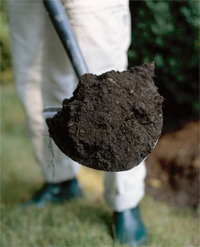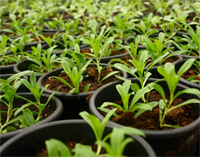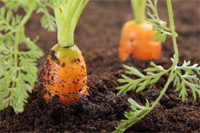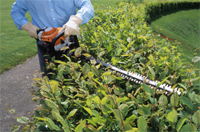How to Select and Care for your Plants...
Prepare the Ground for Planting
 Most plants prefer a compost and nutrient-enriched soil that is well-drained yet able to retain moisture. Whether your soil is sand or clay based, adding organic matter will improve its texture, nutrient content and water movement patterns.
Most plants prefer a compost and nutrient-enriched soil that is well-drained yet able to retain moisture. Whether your soil is sand or clay based, adding organic matter will improve its texture, nutrient content and water movement patterns.Thorough soil preparation prior to planting is essential for long-term success. This is the only opportunity you will have to work the soil completely. Once plants are established, drainage and aeration cannot be substantially corrected without uprooting the plants.
Test your soil to determine its pH, and adjust if necessary. Most perennials will perform well if the pH falls between 5.5 and 6.5. Acid-loving shrubs including Azaleas, Rhododendrons and evergreens require an acid soil of 5.0-6.0. Roses prefer a slightly acid soil of 6.0-6.5. Annuals, herbs and vegetables mostly prefer a pH between 6.0 and 7.0.
Soil preparation work can be performed any time the soil is not frozen or excessively wet. Dig to a minimum of 12", the deeper the better for root development. A 4-6" layer of organic matter such as well-rotted manure, compost and peat moss should be worked into the soil by digging, spading or rotary tilling. In most cases, thoroughly mix 2 lbs. of an organic blend fertilizer. (Garden Tone, Plant Tone or Bone Meal) or a commercial granular fertilizer (5-10-5, 10-10-10, or superphosphate) at the rate of 2 lbs. per 100 sq. ft. into the top 6" of soil. This will be of benefit in successful plant establishment.
How to Plant
 Potted perennials, shrubs and roses can be planted at any time during the growing season. Tender annuals and vegetables should not be planted before the frost-free date (mid-May at the earliest for this area). Hardy transplants can be planted a month before the frost-free date as long as they are hardened off first. Hardening off is merely a gradual adjustment to a new (colder) growing environment. You can set plants out on a covered porch for a few days to acclimate them before planting in the ground.
Potted perennials, shrubs and roses can be planted at any time during the growing season. Tender annuals and vegetables should not be planted before the frost-free date (mid-May at the earliest for this area). Hardy transplants can be planted a month before the frost-free date as long as they are hardened off first. Hardening off is merely a gradual adjustment to a new (colder) growing environment. You can set plants out on a covered porch for a few days to acclimate them before planting in the ground.Carefully remove the plant from the pot. If the roots are wrapped around the bottom of the pot, gently tease them apart with your fingers. If they are too dense to accomplish this, a knife can be used to cut through the root mass. Spread the roots and set the plant at the same level it was in the container. Firm the soil around the plant to eliminate any air pockets around the root system. Water the plants thoroughly.
Do not plant too early in the spring when soil moisture levels are high and temperatures are very cold. Planting at this time may ruin soil structure and result in poor root growth. Late-season plantings should be completed a month before killing frosts so roots can get well established prior to the onset of winter. All late-season plantings should be mulched for their first winter to minimize the chance of winter damage.
Watering
Mulching
 The proper use of summer mulches reduces moisture loss, cuts down on weeding and keeps plant roots cool and moist. A 2-3" layer of mulch is suggested. Do not mulch over the crown of the plant as this can cause rot. Organic materials like shredded leaves and bark are good choices. Routine mulching of established plantings in the fall may be good insurance against winter injury. Materials that can be used include evergreen boughs, marsh hay or pine needles. Do not apply these winter mulches until the ground is frozen and be certain to remove them as soon as the plants commence growth in the spring.
The proper use of summer mulches reduces moisture loss, cuts down on weeding and keeps plant roots cool and moist. A 2-3" layer of mulch is suggested. Do not mulch over the crown of the plant as this can cause rot. Organic materials like shredded leaves and bark are good choices. Routine mulching of established plantings in the fall may be good insurance against winter injury. Materials that can be used include evergreen boughs, marsh hay or pine needles. Do not apply these winter mulches until the ground is frozen and be certain to remove them as soon as the plants commence growth in the spring.
Staking
Division
Deadheading
Annual Care
 Annual flowers complete their life-cycle in one growing season. They give a longer, continuous display of bloom than any other flower. Annuals are easy to grow, providing plenty of choice and value. Whether you have a large enough space to plant a flower bed or a small porch or balcony for hanging baskets and containers, everyone can enjoy growing flowers. Full sun (six or more hours of direct sunlight) is best for most annuals. Others prefer part-shade (two to six hours of direct sunlight) or shade (indirect sunlight). The soil needs to be fertile and moist with an average pH of between 6.0 and 7.0. Annuals are not as deep rooted as perennials, so they do not require as deeply a prepared bed. However, loosening the soil to about a foot will allow moisture to penetrate and drain properly.
Annual flowers complete their life-cycle in one growing season. They give a longer, continuous display of bloom than any other flower. Annuals are easy to grow, providing plenty of choice and value. Whether you have a large enough space to plant a flower bed or a small porch or balcony for hanging baskets and containers, everyone can enjoy growing flowers. Full sun (six or more hours of direct sunlight) is best for most annuals. Others prefer part-shade (two to six hours of direct sunlight) or shade (indirect sunlight). The soil needs to be fertile and moist with an average pH of between 6.0 and 7.0. Annuals are not as deep rooted as perennials, so they do not require as deeply a prepared bed. However, loosening the soil to about a foot will allow moisture to penetrate and drain properly.To keep the plants in bloom as long as possible, flower heads should be cut as soon as they fade, before they have time to set seed. Feeding regularly throughout the summer is essential for the long-term health of your plants. We add a slow release supplement to all of our hanging baskets. However, we strongly recommend that you incorporate using a water soluble fertilizer (Peters or Miracle Gro) into your regular watering regimen. For your own beds and containers, use a slow release fertilizer (Osmocote) in the soil in addition to a water soluble fertilizer.
Herb Care
Vegetable Care
 The most important consideration for a vegetable garden is sunlight. Be sure the location you choose receives a minimum of six hours of direct exposure. The preferred pH of most vegetables is between 6.0 and 7.0. The ideal soil is sandy loam with good drainage. Prepare the soil carefully before planting by digging in compost and other organic matter which will get you off to a good start. Quick-growing crops such as lettuces and bush beans probably won't need additional fertilizers, but longer season vegetables like tomatoes and peppers should receive an additional boost of compost or manure once they have set flower. Vegetables generally need about an inch of water per week. Watering early in the day is best and be sure to water the plant's root zone in order to ensure the plant is receiving the maximum benefit from the watering.
The most important consideration for a vegetable garden is sunlight. Be sure the location you choose receives a minimum of six hours of direct exposure. The preferred pH of most vegetables is between 6.0 and 7.0. The ideal soil is sandy loam with good drainage. Prepare the soil carefully before planting by digging in compost and other organic matter which will get you off to a good start. Quick-growing crops such as lettuces and bush beans probably won't need additional fertilizers, but longer season vegetables like tomatoes and peppers should receive an additional boost of compost or manure once they have set flower. Vegetables generally need about an inch of water per week. Watering early in the day is best and be sure to water the plant's root zone in order to ensure the plant is receiving the maximum benefit from the watering.
Perennial Care
Shrub Care
 Again, if your shrubs are planted in rich soil, heavy fertilizing will not be needed. Flowering shrubs will benefit from the same fertilizers that are discussed above in 'perennial care'. If you grow acid-loving shrubs including Azaleas, Rhododendrons, and evergreens, you can increase the acidity of your soil by using a combination of Holly Tone and Miracid.
Again, if your shrubs are planted in rich soil, heavy fertilizing will not be needed. Flowering shrubs will benefit from the same fertilizers that are discussed above in 'perennial care'. If you grow acid-loving shrubs including Azaleas, Rhododendrons, and evergreens, you can increase the acidity of your soil by using a combination of Holly Tone and Miracid.Many shrubs benefit from seasonal pruning, which encourages new growth. The time and degree of pruning depends on the particular variety of shrub.
We recommend taking some winter precautions to ensure the healthy return of your shrubs year to year. Protect your shrubs from deer by wrapping them in burlap during the winter months. For evergreens including Azaleas, Rhododendrons, and conifers, we recommend that you apply Wilt Pruf to your shrubs in late fall or early winter. Wilt Pruf is an anti-transpirant that coats the leaves in a waxy residue that helps to prevent moisture loss. On a sunny winter day, moisture is lost from the leaves since water cannot be taken up from the frozen soil. Excess moisture loss results in winter kill.
Rose Care
 Roses benefit from an early spring pruning and the removal of dead canes. Feed your roses with organic Rose Tone fertilizer, a water-soluble fertilizer such as Peters or Miracle Gro, or apply a slow release fertilizer to the area like Osmocote. Stop feeding roses in mid-August in order for them to slow their growth before frost.
Roses benefit from an early spring pruning and the removal of dead canes. Feed your roses with organic Rose Tone fertilizer, a water-soluble fertilizer such as Peters or Miracle Gro, or apply a slow release fertilizer to the area like Osmocote. Stop feeding roses in mid-August in order for them to slow their growth before frost.Clean up all leaves and debris from around the plants in fall, since dead foliage can harbor pests and fungal spores that induce disease. For winter protection, it is advisable to build a mound of mulch or soil around the graft. Remove the winter mulch in spring.